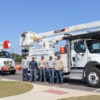“The future will be sound and brighter,” according to Retirement Systems of Alabama Chief David Bronner. This future prediction is the heading of a report, on the RSA website, outlining the information given to the state legislature’s joint budget hearing Feb. 8, 2012. This online report is impressive and colorful, with many charts and graphic illustrations.
After we have been sufficiently impressed by the reports depth and skillful presentation the major facts begin to jump out at us. The facts of the most consequence to the tax papers and the whole economy of Alabama concern the retirement systems unfunded liability. According to this latest report that unfunded taxpayer liability grew by $2.37 billion or 30 percent from 2008 through 2010. This tax payer obligation has been growing before 2008, growing in the years before the great recession, and continued to swell in 2011.
The most startling and alarming facts are shown on a pie chart titled “Sources of Pension Payments to Retirees.” As indicated by this chart we have a state retirement system whose investment returns are only 50 percent of what is required to meet current pension payments. The funding for the other half of these state promised entitlements is shown to come from two sources. About 40 percent of the total monies come from what the chart calls employer contributions. The remaining 10 percent is from employee contributions.
Let us discuss these sources of funding in order. First investment returns. Information from the Feb. 8th budget hearing shows a total return on investment over 10 years of near 4.11 percent for the system as a whole. The RSA returns are shown in comparison to the performance of various unmanaged indexes over the same time period. While it is true the many indexes, and they are numerous, are a bench mark that can be sighted you can almost always find an index that you can beat and one that will beat you.
While an index is an unmanaged unit, the retirement systems of Alabama is not unmanaged. A more reasonable, apples to apples, comparison which the RSA would come from the large, well known and highly rated, conservative asset allocation and high quality bond funds found in Morning Star Inc. fund investor publication. These are all publicly traded investments available to everyone including individuals and institutions alike.
Here are some examples for your comparison:
Retirement Systems of Alabama as of Dec. 31, 2011
10 year average total return 4.11 percent per year
Total assets 25 Billion, 23 Million dollars
American Funds Inc. Income Fund of America “A” as of Dec. 31, 2011
10 year average total return 6.2 percent per year
Total assets $66,643,000,000
American Funds Inc. Capitol Income Builder “A” as of Dec. 31, 2011
10 year average total return 6.7 percent per year
Total assets $73,651,000,000
Vanguard Inc. Vanguard Wellesley Income Inv. as of Dec. 31, 2011
10 year average total return 6.7 percent per year
Total assets $25,898,000,000
Franklin Templeton Investment Inc. Franklin Income “A” as of Dec. 31, 2011
10 year average total return 7.3 percent per year
Total assets $57,971,000,000
Pimco Inc. (High Quality Bond) Pimco Total Return “D” as of Dec. 31, 2011
10 year average total return 6.5 percent per year
Total assets $244,055,000,000
Vanguard Inc. Vanguard Total Bond Market Index ADM. as of Dec. 31, 2011
10 year average total return 5.6 percent per year
Total assets $92,249,000,000
Here we have just six of the many such large stable investments that may be a more fair comparison when looking at our retirement system. These six funds combined have total assets of $560,467,000,000 and a 10 year average total return of 6.5 percent per year. This 6.5 percent return is 2.39 percent greater than the RSA return of 4.11 percent for the same period. What does 2.39 percent mean on a $25 billion investment over 10 years? How about $5,975,000,000 if this additional income was taken out and spent each year for 10 years. But if the additional income was not spent but reinvested each year this figure increases to $6,660,330,000. I know the very size of these numbers will make your head spin, but the calculations are just sixth grade arithmetic.
Moving on, the RSA pie chart tells us that about 40 percent of the current monies being paid to retired employees come from employer contributions. Dr. Bronner, we need to word this more clearly. The employer you speak of is the taxpayer and the tax money going to fund the retirement system is the fruit of his/her labor. Please remember that.
The 10 percent of current payout that is shown as being funded from employee contributions is beyond understanding. Using the retirement contributions of working employees to pay for the entitlements of retired employees may not be unlawful if you are the state or federal government. But if you are a private business owner trying this may land you in jail. The use of incoming monies, that employs think are being invested for their benefit, to pay the promised income of a retired person is a classic example of a pyramid scheme. Dr. Bronner do you know who Bernie Madoff is and why he is behind bars? This type of scheme may be legal for governments, but that does not make it right.
Looking at the subpar returns of the RSA we need to remember that about 12 percent of the funds are invested in real estate and other alternative investments. The problems concerning real estate and alternative investments are almost incomprehensible. They require more research and much more time and space than we have today. But we will get there.
If asked, average people in Walmart, in Birmingham, Mobile, Florence, or Dothan, what they think of the retirement systems of Alabama, even if they don’t work for some form of government, they will probably say, this is Alabama, it must be fine. If pressed most will also think it is self financing. Unfortunately, they would be totally wrong.













































